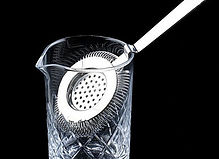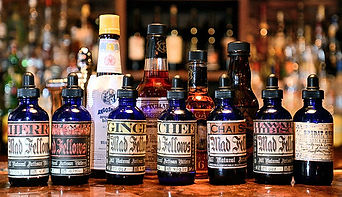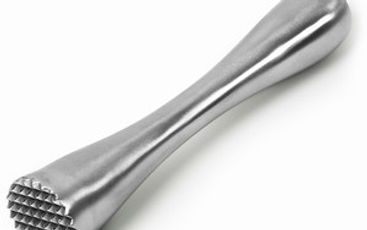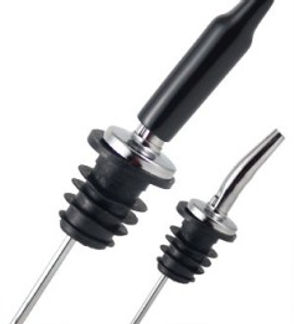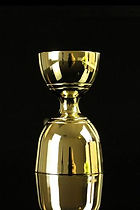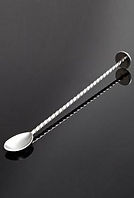
U need for making cocktails..
Dropper Bottle
These amber colored dropper bottles are perfect for cocktail bitters! Bottle includes an eyedropper that’s built right into the cap for easy, perfectly portioned dispensing.

Shaker
The bartender basic tool. Use a shaker for drinks that contain fruit juices, syrups, liqueurs, thick or other ingredients that require more in-depth is shaken. The shaker must occupy two drinks and ice relatives! The most common and easiest to use stainless steel shaker, filter built into the lid and cap can be used as standard equipment.
Tip: Do not tighten the shaker top on it, so as not be harvested after shaking.
The drink shaker filled when the joints are not leaking!
Bitter bottle
Inspired by a design from the 1880's. They have a capacity of 100ml or 3.3 ounces, and are fitted with a stainless steel and cork dasher top. These bottles are ideal for consistently delivering a dash
Filter
There are two kinds of filter, the filter is known to Hawthorn, few people know the Julep strainer. Long, flexible spirálról in Hawthorn around the rim of the filter can be known. Due to this great fit different sized up shakers, as well as the spiral keeps a shaker with ice cubes while the mixed liquor passes nicely.
The julep strainer with a perforated spoon to remind us. This type of filter may be difficult to obtain, primarily needed to use Boston shaker, because the filter does not match Hawthorn transparent upper part of the shaker!
Muddler
A muddler is a bartender's tool, used like a pestle to mash—or muddle—fruits, herbs and spices in the bottom of a glass to release their flavor.
peeler
There are a variety of ways of making and using twists. Twists are typically cut from a whole fresh fruit with a small kitchen knife immediately prior to serving, although a peeler, citrus zesters, or other utensil may be used. A curled shape may come from cutting the wedge into a spiral, winding it around a straw or other object, or as a byproduct of the cutting.
Speed Pourer
Anyone in the know knows the beauty of the speed, or bottle, pourer. The main benefit of the speed pourer is that it streamlines the flow of liquid coming out of the bottle (helping to avoid spills and splashes) while giving you greater control over the amount of alcohol that is poured. It is essential to the professional bartender and a nice-to-have for any home bar.
Cutting Board
Kitchen cutting boards are often made of wood or plastic and come in various widths and sizes. There are also cutting boards made of glass, steel, or marble, which are easier to clean than wooden or plastic ones such as nylon or corian, but tend to damage knives due to their hardness. Rough cutting edges—such as serrated knives—abrade and damage a cutting surface more rapidly than do smooth cutting implements.
Jigger
Jiggers are the basic hourglass-shaped stainless-steel measuring device you've seen in many a bar. These are cheap and easy to find in most housewares stores, or online. Typically, the larger cup measures out exactly one jigger, or 1 1/2 ounces. The smaller cup is normally one half jigger, or 3/4 ounces.
Citrus squeeze
Fairly self explanatory. Used to squeeze your limes and lemons, because remember to ALWAYS use fresh squeezed citrus juice. The U.S. Patent and Trademark Office lists over 200 patents for citrus squeezers, but the type seen in the image is recommended as it works very well for both lemons and limes as well as it directs the juices in a precise manner
Ice Pick
An ice pick is a tool used to break up, pick at, or chip at ice. It resembles a scratch awl, but is designed for picking at ice rather than wood. Before the invention of modern refrigerators, ice picks were a ubiquitous household tool used for separating and shaping the blocks of ice used in ice boxes.
Mixing Glass
Mixing Glasses are an essential bartending supply for any professional bartender or master mixologist who is serious about creating exciting craft cocktails! Whether you are a high pace nightclub bartender serving up rounds of shots all night long, or even a home bar enthusiast creating your own secret recipe cocktails for your guests, you know the importance of having a high quality mixing pint glass. You may prefer a high end, Diamond Pattern Mixing Pitcher or Beaker for stirring up your signature martini, or maybe some stemmed glassware to give your bar an elegant touch? Either way, we’ve got you covered! Now all you have to do, is ask yourself…
Do you like it shaken or stirred?
Bar Spoon
A bar spoon is a long handled spoon used in bartending for mixing and layering of both alcoholic and non-alcoholic mixed drinks. Its length ensures that it can reach the bottom of the tallest jug or tumbler to mix ingredients directly in the glass.
A bar spoon holds about 5 millilitres of liquid (the same as a conventional teaspoon) or 2.5 ml of liquid (standard size in Europe). Its long handle is similar to an iced tea spoon, but is usually decorative and elegant – some variations mimic large swizzle sticks, with a disc at one end. The shaft is typically thin and threaded so that the fingers can easily grip and rotate the spoon.









